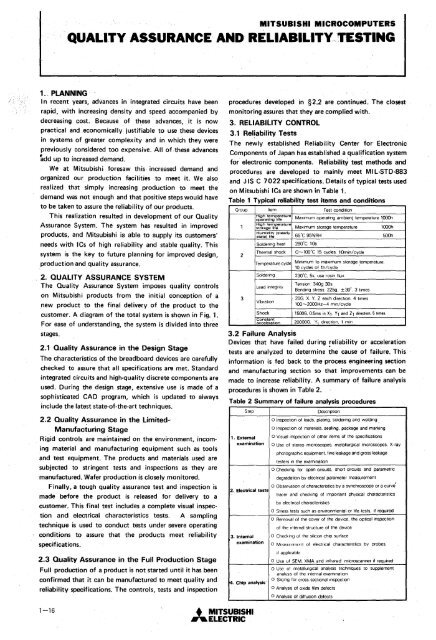mitsubishi - Al Kossow's Bitsavers
mitsubishi - Al Kossow's Bitsavers
mitsubishi - Al Kossow's Bitsavers
Create successful ePaper yourself
Turn your PDF publications into a flip-book with our unique Google optimized e-Paper software.
. MITSUBISHI MICROCO.MPUTERSQUALITY ASSURANCE AND RELIABILITY".TESTING1 .. PLANNINGI n recent years, advances in integrated Circuits have beenrapid, with increasing density and speed accompanied bydecreasing cost. Because of th.ese advances, it is nowpractical and .economically justifiable to use these devicesin systems of greater complexity and in which they werepreviously considered too expensive. <strong>Al</strong>l of.. these advances~dd up to increased demand.We at Mitsubishi foresaw this increased demand andorganized our production facilities to meet it. We alsorealized that simply increasing production to meet thedemand was not enough and that positive steps would haveto be taken to assure the reliability of our products.This realization resulted in development of our QualityAssurance System. The system has resulted in improvedproducts, and Mitsubishi is able to supply its customers'needs with ICs of high reliability and stable quality. Thissystem is the key to future planning for improved design,production and quality assurance.2. QUALITY ASSURANCE SYSTEMThe Quality Assurance System imposes quality controlson Mitsubishi products from the initial conception of anew product to the final delivery of the product to thecustomer. A diagram of the total system is shqwn in Fig. 1.For ease of understanding, the system is divided into threestages.2.1 Quality Assurance in the Design StageThe characteristics of the breadboard devices are carefullychecked. to assure that all specifications are met. Standardintegrated circuits and high·quality discrete components areused. During the design stage, extensive use is made of asophisticated CAD program, which is updated to alwaysinclude the latest state-of-the-art techniques.2.2 Quality A.ssurance in the Limited-Manufacturing StageRigid controls are maintained on the environment, incomingmaterial and manufacturing equipment such as toolsand test equipment. The products and materials used aresubjected to stringent tests and inspections as they aremanufactured. Wafer production is closely monitored.Finally, a tough quality assurance testand inspection ismade before the product is released for delivery to acustomer. This final test includes a complete visual inspectionand electrical characteristics tests. A samplingtechnique is used to conduct tests under severe operatingconditions to assure that the products meet reliabilityspecifications.2.3 Quality Assurance in the Full Production StageFull production of a product is not started until it has beenconfirmed that it can be manufactured to meet quality andreliability specifications. The controls, tests and inspectionprocedures developed in §2.2 are continued. The closestmonitoring assures that they are complied with.3. RELIABll.ITY CONTROL3.1 Rel~ability TestsThe newly established Reliability Center for ElectronicComponents of Japan has established a qualification systemfor electronic components. ReliabilitY test methods andprocedures are developed to mainly meet MI L-STD-883and JIS C 7022 specifications. Details of typical tests usedon Mitsubishi ICs are shown in Table 1.Table 1 Typical reliability test items and conditionsGroupItemHigh temperatureoperating lifeHumidity (steadystate) lifeSoldering heatThermal shockTest conditionMaximum operating ambienl temperature l,o(lOhMaximum storage temperature65'C 95%RH260'C lOs0-IOO'C 15 cycles. 10min/cycleTemperaturecycle ~n~~c~: ~~ ~~~i~~m storage ~emperatllre.SolderingLead integrityVibrationShockConstantacceleration230·C. 5s. use rosin fluxTension 340g 30sBending stress: 225g. ± 30'. 3 times20G. X. Y. Z each direction. 4 times100-2000Hz-4 min/cycle1500G. 0.5ms in X,. y 1 and Z 1 direction. 5 time •.20000G. Y I direction. 1 minl000h500h3.2 Failure AnalysisDevices that have failed during [eliability or acceleration. tests are analyzed to determine the cause of failure, Thisinformation is fed back to the process engineering sectionand manufacturing section so that improvements can bemade to increase reliability. A summary of failure analysisprocedures is shown in Table 2.Table 2 Summary of failure analysis proceduresStep1. ExternaleJlaminationo Observation of characteristics by a synchroscope or a curve'2. Electrical teststracer and checking of important physical characteristics3. InternalexaminationlIDescriptiono Inspection of leads. plating. soldering and weldingo Inspection of materials. sealing. package and markingo Visual inspection of other items of the specificationsOUse of stereo microscopes .. meta.llurgical microscopes. X-rayphotographic eqUipment. fine leakage and gross leakagetesters in the examinationo Checking for open circuits. short circuits and parametricdegradation by electrical parameter measurementby electrical characteristicso Str'ess tests such as environmental or life tests. if requiredo Removal of the cover of the device. the optical inspectionof the internal structure of the deviceo Checking of the silicon chip surfaceo MeaSlIl"Il11>l1t of eleclrlcal characteristics by probes.if applicableo Use of SEM. XMA and Infrared microscanner if requiredo Use of metallurgical analYSIS techniques to supplementanalYSIS of the Internal examination4. Chip analysis' 0 SIi

















